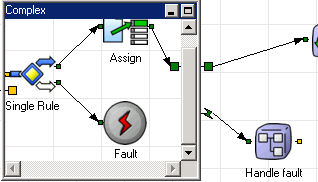
A fault within a complex activity serves as a method to interrupt the normal activity flow, sending the control to another activity flow that is connected to the fault handler. A fault is typically connected to the False node of a rule to handle exceptions to what is expected at runtime.
Requirements: The constructs for handling faults require both a Fault in the complex activity and a Fault Handler node attached to the outside of the complex activity.

When an unexpected condition leading to the fault is detected at a particular point in business logic, processing picks up at the error handling point in the flow, and continues from there. The user can express multiple error detection points but only a single error handling flow per complex activity that will execute when any of those errors are detected.
The fault exception flow outside of the normal activity flow defines the handling of these occurrences at runtime.